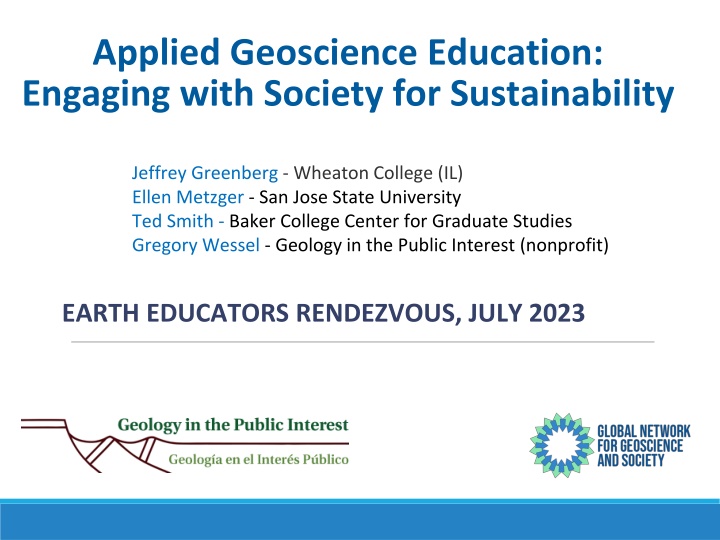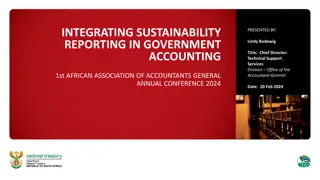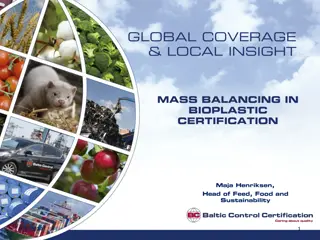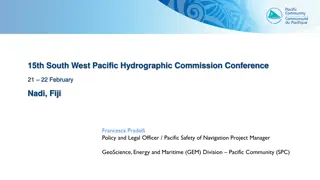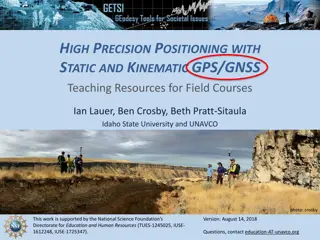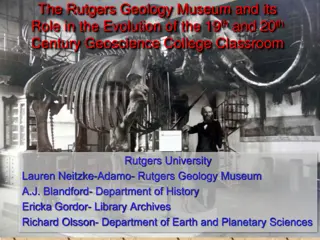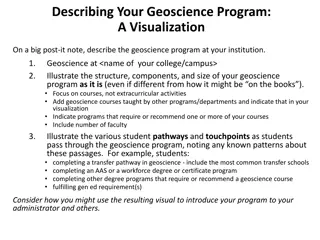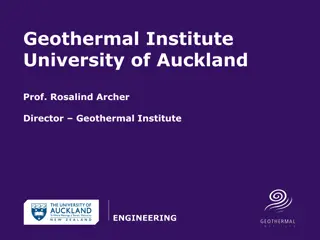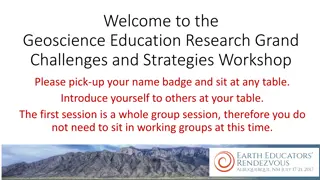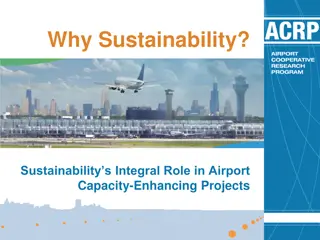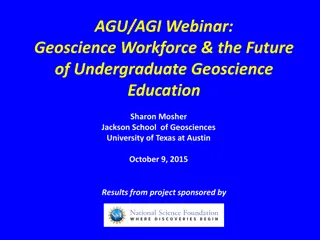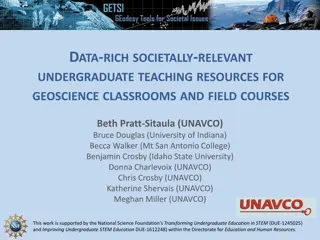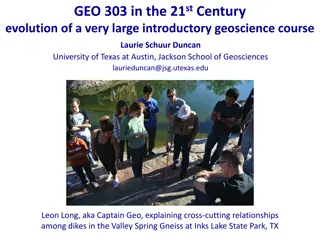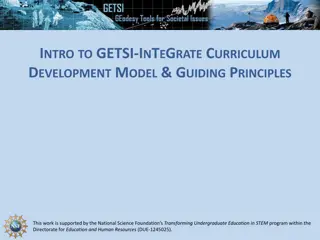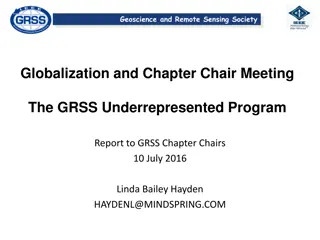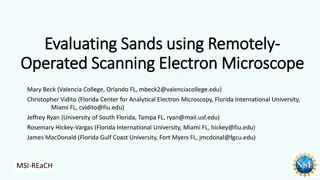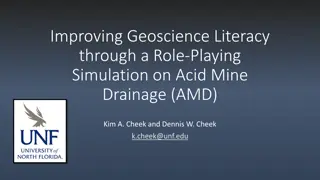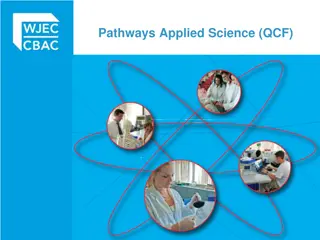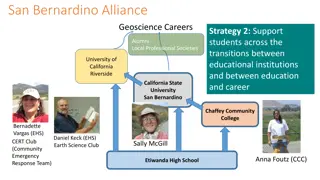Applied Geoscience Education for Sustainability
Engage with society for sustainability in applied geoscience education. Explore best practices, case studies, and resources for teaching geoscience. Discuss important skills, challenges, and barriers while developing individual plans for enhanced instruction.
Download Presentation

Please find below an Image/Link to download the presentation.
The content on the website is provided AS IS for your information and personal use only. It may not be sold, licensed, or shared on other websites without obtaining consent from the author.If you encounter any issues during the download, it is possible that the publisher has removed the file from their server.
You are allowed to download the files provided on this website for personal or commercial use, subject to the condition that they are used lawfully. All files are the property of their respective owners.
The content on the website is provided AS IS for your information and personal use only. It may not be sold, licensed, or shared on other websites without obtaining consent from the author.
E N D
Presentation Transcript
Applied Geoscience Education: Engaging with Society for Sustainability Jeffrey Greenberg - Wheaton College (IL) Ellen Metzger - San Jose State University Ted Smith - Baker College Center for Graduate Studies Gregory Wessel - Geology in the Public Interest (nonprofit) EARTH EDUCATORS RENDEZVOUS, JULY 2023
Welcome! Speed Introductions Please introduce yourselves: Your name Your institution Why you are here? (1-2 sentences)
Workshop Goals Highlight the importance of teaching applied geoscience to address local socio-environmental priorities that are important to K-16 students Explore best practices in applied geoscience education Examine case studies/examples of community-based geoscience learning Identify and evaluate resources for teaching applied geoscience Develop individual plans for enhancing applied geoscience instruction. Download the Action Plan template
Six questions to guide discussion Why is it important to incorporate an applied approach into teaching geoscience? What are the most relevant geoscience challenges that appeal to current students? What are the most important skills we can teach to prepare students for careers? What are the best practices for teaching applied geoscience? What resources are the most important and what organizations can supply those resources to help facilitate an applied approach to teaching? What are the biggest barriers to instituting applied geoscience in our teaching and in engaging with society?
Workshop Norms According to the internet: Start on time and end on time; put smartphones on stun; treat everyone with respect; don t hog the podium; be constructive; state views and ask genuine questions; share all relevant information; use specific examples and agree on what important words mean; explain reasoning and intent; focus on interests, not positions; jointly design next steps; discuss undiscussable issues; explicitly agree on the ground rules; develop a team mindset that s congruent with the ground rules; agree that everyone is responsible for helping each other use the ground rules; discuss how you are using the ground rules and how to improve. According to Greg Wessel s mother: Be kind. Be civil. Make sense.
Day 1: Setting the Stage Introductions/workshop overview Reflecting on geoscience and sustainability Gallery walk and discussion Geoscience and the Sustainable Development Goals (Activity) Individual Reflection
What is Sustainability? Sustainability has many meanings What does the word sustainability mean to you?
What is sustainability? - Activity Slightly modified from the Sustainability Buffet activity by Laura Webb. Part 1 Individually examine the written definitions and graphics provided Choose your preferred and least preferred definitions/graphics. Collectively, discuss your choices and why you made them. Part 2 Watch this video on Doughnut Economics (2:52) How did the ideas expressed in this video resonate with your earlier discussion? What new insights or questions need further discussion? See Additional Workshop Resources in the Workspace for a Word doc
The most common definition The World Commission on Environment and Development (the Brundtland Commission) in its report Our Common Future (1987): Sustainable development is development that meets the needs of the present without compromising the ability of future generations to meet their own needs. Intergenerational equity
Sustainability: More than the environment Three dimensions of sustainability: The 3 Es Environment Economy Society (Equity) Includes intra- and intergenerational equity
Models of Sustainability https://link.springer.com/article/10.1007/s11625-018-0627-5
A set of 17 goals for the world s future, through 2030 Backed up by a set of 169 detailed Targets Negotiated over a three- year period at the United Nations Agreed to by nearly all the world s nations, on 25 Sept 2015 Central promise: Leave no one behind
Universality These Goals apply to every nation and every sector. Cities, businesses, schools, organizations, all are challenged to act. Integration It is recognized that the Goals are all inter-connected, in a system. We cannot aim to achieve just one Goal. We must achieve them all. Transformation It is widely recognized that achieving these Goals involves making very big, fundamental changes in how we live on Earth.
Recent Report Geoscience in Action: Advancing Sustainable Development UNESCO, American Geophysical Union (2023) From the Short Summary: Geoscience is going through an identity crisis. Enrollment in geology courses is declining in many countries. Geoscience needs to find a new purpose that is more in tune with evolving societal needs and the expectations of budding scientists.
Geoscience in Action (cont.) 1. Mapping geoscience contributions 2. Geoscience & the three dimensions of people, planet & prosperity 3. Geoscience competencies 4. How geoscience advances the SDGs: some examples 5. Geoscience sustainability: defining the stakeholders and impact 6. Questions to prompt further engagement 7. Paths forward for geoscience 8. References and Additional Resources The dominant SDGs for geoscience highlighted within each dimension.
How Geoscience Advances the SDGs: Some Examples Water Resources Waste Disposal Geologic Hazards and Engineering Mineral Resources Energy Resources Climate Change Consequences Environmental Preservation/Remediation
Gallery Walk: Why is it important to incorporate an applied approach into teaching geoscience? What are the most relevant geoscience challenges that appeal to current students? What are some key attributes (knowledge, skills, tools, etc.) of geoscience that can be directed to sustainability issues? What was your main take-away from the reading for today?
Think-Pair-Share Identify one or more geoscience-related issues in your community that may provide an opportunity to engage students problem solving
Geoscience and the SDGs Activity Review the Geoscience Sustainability Clock graphic (p. 14 in Geoscience and Action) How does what you teach/want to teach connect to the Sustainable Development Goals?
End-of-Day Individual reflection (see Action Plan Template) Road Check Homework for Day 2: Please Read Greenberg, et al. 2012: The many educational facets of development cooperation between a Kosovan village and earth scientists (PDF available in the Workspace)
